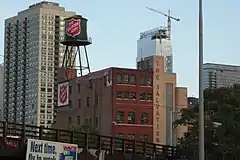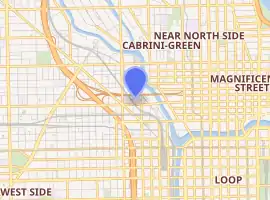Wrigley Lodge
Wrigley Lodge is a building at 509 N. Union, Chicago, Illinois. Owned by the Salvation Army since 1931, it presently houses a Salvation Army Thrift Store.[1]
| Wrigley Lodge | |
|---|---|
 | |

| |
| General information | |
| Location | 509 N. Union, Chicago, Illinois |
| Coordinates | 41°53′30.3″N 87°38′43.9″W |
| Completed | 1891 |
| Owner | The Salvation Army |
| Technical details | |
| Floor count | 6 |
| Design and construction | |
| Architect | C.J. Furst Charles Rudolph |
History
Early uses
The building was designed by the architectural firm of Furst & Rudolph and was built in 1891 by Biemolt & Carter at a cost of between $40,000 and $50,000.[1][2][3][4] The building was originally the Braun & Fitts Butterine Factory.[1][2][3] In 1897, a law was enacted in Illinois prohibiting the coloring of butterine.[5][6] In response, Braun & Fitts and Chicago's other butterine manufacturers threatened move their operations out of the state.[5][6] However, Chicago's butterine producers decided to continue manufacturing and coloring butterine until arrests would be made, so the constitutionality of the law could be tested.[7][8] The company's name was changed to John F. Jelke Company in 1906.[9]
In 1912, the Dairy Farm Products Company purchased the building from the John F. Jelke Company.[10] The Dairy Farm Products Company opened its plant in the building on October 17, 1912, manufacturing butter.[11] In 1916, the building was sold to William Wrigley Jr. for approximately $125,000.[12][13] The building would house the factory and offices of the Downey-Farrell Company, a margarine manufacturer that Wrigley was affiliated with.[13][14][15] An addition was built in 1917, designed by Postle & Fischer, at a cost of $40,000.[1][16] In 1923, the building was purchased by the Duz Company, a manufacturer of soap powder, for $384,000.[17] Wrigley re-purchased the building in 1929.[18]
Salvation Army ownership
| Wikimedia Commons has media related to Wrigley Lodge. |
William Wrigley Jr. gave the Salvation Army use of the building on October 11, 1930 to use as a lodging house for the unemployed.[19][20] It was named the New Start Lodge and was formally opened at 3:30 pm on October 23, 1930.[21][20][22] It contained 2,020 beds, and facilities to feed a similar number.[23] Wrigley donated the property to them outright the following year, and it was re-named Wrigley Lodge.[20][24] Following World War II, it served as a rehabilitation center for veterans.[25][26]
In 1946, the Salvation Army began raising funds for the remodeling of Wrigley Lodge and the construction of new buildings.[25][26] It was remodeled in the Streamline Moderne style, designed by Albert C. Fehlow, at a cost of $400,000, and was re-dedicated at 2 pm on January 18, 1951.[27][1][28][29] A new one-story warehouse was also built behind the north half of the building.[28] The building replaced the Central Social Service center, which was demolished to make way for the construction of the Congress Expressway, and served as a rehabilitation center for homeless and disabled men, with housing accommodations for 150 men.[28][29] The thrift store, located in the building, funded the center's operations and employed some of the men residing in the building.[28]
In the following years, the building has served the Salvation Army in similar roles, and continues to house a thrift store as part of a multi-building complex owned by the Salvation Army.[1][30][31][32] The building's rooftop water tower was restored in 2017.[33] The Salvation Army announced their intention to sell the complex in August 2019.[32]
References
- American Institute of Architects Chicago (2014) AIA Guide to Chicago. Third Edition. University of Illinois Press. p. 170. Retrieved October 12, 2019.
- The Real Estate and Building Journal. Vol. 33, No. 1. June 27, 1891. pp. 918, 920. Retrieved October 16, 2019.
- Meyer, Henry C. (1891). The Engineering Record. Vol. 24. p. 227. Retrieved October 16, 2019.
- "Chicago Real Estate", Chicago Tribune. August 30, 1891. p. 25.
- "Hit at Butterine Trade; Vast Chicago Industry Depends on Governor Tanner's Pen", Chicago Tribune. June 8, 1897. p. 9.
- "Kills a City Industry; Tanner Ends Butterine Making Here, Manufacturers Say", Chicago Tribune. June 16, 1897. p. 9.
- "Will Continue to Make Butterine", Chicago Tribune. July 11, 1897. p. 13.
- Farmers' Review. Volume 28, No. 30. July 28, 1897. p. 465. Retrieved December 20, 2019.
- The Book of Chicagoans: A Biographical Dictionary of Leading Living Men of the City of Chicago. A.N. Marquis & Company. 1911. p. 429. Retrieved October 18, 2019.
- "Butter Concern Buys Plant Here; Dairy Farm Products Company Gets Jelke Site for Big Establishment", Chicago Tribune. March 23, 1912. p. 13.
- "Factory at 509 North Union Street, of Dairy Farm Products Company Is in Operation", Chicago Daily Produce. October 22, 1912. p. 16. Retrieved October 18, 2019.
- "Wrigley Buys Former Jelke Butter Plant", Chicago Tribune. October 31, 1916. p. 20.
- "Wrigley Purchases Plant for Butterine Company", Chicago Tribune. November 5, 1916. p. 19.
- Service and Regulatory Announcements. United States Department of Agriculture Bureau of Animal Industry. June 1917. p. 62. Retrieved October 18, 2019.
- Poor's and Moody's Manual Consolidated, Industrial Section. Vol. 1. Blair & Co. 1921. p. 537. Retrieved October 18, 2019.
- The Iron Age. Vol. 99. January–June 1917. p. 294d. Retrieved October 18, 2019.
- "Latest News of Chicago Industrial Plans", Chicago Commerce. September 8, 1923. p. 40. Retrieved September 19, 2019.
- "Wrigley Buys 2 Buildings at 509 North Union", Chicago Tribune. November 27, 1929. p. 20.
- "New West Side Lodging House for Unemployed is Opened", Chicago Tribune. October 14, 1930. Retrieved October 19, 2019.
- "William Wrigley Jr. Gives Buildings Used by Salvation Army", Chicago Tribune. June 22, 1931. Retrieved October 19, 2019.
- "Wrigley Officially Presents Building to Salvation Army", Chicago Tribune. June 23, 1931. p. 19.
- "Dedicate Home for Chicago's Homeless Today", Chicago Tribune. October 27, 1930. p. 4. Retrieved December 14, 2019.
- "Shelters to Bar Those Coming to the City for Relief", Chicago Tribune. October 2, 1931. p. 7.
- "Chicago Relief Fund Is Past 3 Million Mark", Chicago Tribune. October 22, 1931. p. 19.
- "Salvation Army Seeks $1,500,000; Strategy Set", Chicago Tribune. March 12, 1946. p. 5. Retrieved December 14, 2019.
- "Salvation Army Enlists North Siders in Drive", Chicago Tribune. April 21, 1946. Part 3, p. 5.
- "Wrigley Lodge", Rosin Preservation. Retrieved October 19, 2019.
- "Salvation Army Will Dedicate Center Today", Chicago Tribune. January 18, 1951. Part 3, p. 3.
- "Salvation Army Dedicates New Center Today", Chicago Tribune. January 18, 1951. Part 4, p. 9.
- Fawcett, Adrienne. "It's Time to Move It… Or Donate It to Charity", Chicago Tribune. March 31, 1996. Retrieved October 19, 2019.
- "Salvation Army's Canteens Ready to Roll at Alarm's Ring", Chicago Tribune. January 9, 1966.
- Kozlarz, Jay. "Salvation Army lists River West complex, opening near downtown site for development", Curbed. August 9, 2019. Retrieved October 19, 2019.
- "A Rooftop Water Tank is Saved!", Preservation Chicago. Retrieved October 19, 2019.